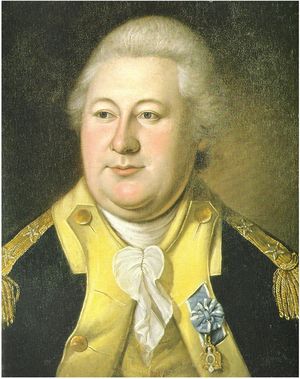Annotation:General Knox's March: Difference between revisions
(Created page with "=='''Back to [[{{BASEPAGENAME}}]]'''== ---- <p><font face="garamond, serif" size="4"> '''GENERAL KNOX'S MARCH.''' American, March (whole time). D Major. Standard tuning (fiddl...") |
No edit summary |
||
| (9 intermediate revisions by 2 users not shown) | |||
| Line 1: | Line 1: | ||
== | __NOABC__ | ||
<div class="noprint"> | |||
<p><font face="Century Gothic" size="4"> Back to [[{{BASEPAGENAME}}]] </font></p> | |||
</div> | |||
---- | ---- | ||
<p><font face=" | {{#lst:{{PAGENAME}}|abc}} | ||
---- | |||
<div style="page-break-before:always"></div> | |||
<p><font face="Century Gothic" size="3"> | |||
<div style="text-align: justify; direction: ltr; margin-bottom: 90px; margin-left: 70px; margin-right: 120px;"> | |||
<br> | <br> | ||
'''GENERAL KNOX'S MARCH.''' AKA and see "[[Colonel McLean's March]]," "[[New Duke of York's March]]," "[[Slow March (1)]]." American (?), March (whole time). D Major (Nixon): C Major (Ditson). Standard tuning (fiddle). AABB. The march was entered into the c. 1776-1778 music copybook of fifer Thomas Nixon Jr. [http://www.framinghamhistory.org/framinghamhistory/Default/exhibit4/e40102b.htm] (1762-1842), of Framingham, Connecticut. Nixon was a thirteen-year-old who accompanied his father to the battles of Lexington and Concord, and who served in the Continental army in engagements in and around New York until 1780, when he returned to Connecticut. | |||
<br> | <br> | ||
[[File:knox.jpg| | <br> | ||
[[File:knox.jpg|300px|thumb|left|General Henry Knox by Charles Wilson Peale]] | |||
The title honors General Henry Knox [http://en.wikipedia.org/wiki/Henry_Knox] (1750-1805), Washington's chief artillery officer throughout the War of American Independance, who dragged cannon on sledges from Fort Ticonderoga to Boston in 1775 to lay siege to the British. Later Knox served as the first Secretary of War in the new government. | The title honors General Henry Knox [http://en.wikipedia.org/wiki/Henry_Knox] (1750-1805), Washington's chief artillery officer throughout the War of American Independance, who dragged cannon on sledges from Fort Ticonderoga to Boston in 1775 to lay siege to the British. Later Knox served as the first Secretary of War in the new government. | ||
<br> | <br> | ||
<br> | <br> | ||
The provenance of the tune is unknown, however. The earliest printing was in John Watlen's '''Celebrated Circus Tunes''' (1791) as "[[New Duke of York's March]], the composition attributed to 'Shroeter'. A version appears as "[[Colonel McLean's March]]" in Glasgow musician James Aird's '''Selection of Scotch, English, Irish and Foreign Airs, vol. 6''' (1803), and another in the 1860's music manuscript collection of Lancashire fiddler William Tildesley as "[[Slow March (1)]]." | |||
<br> | |||
<br> | |||
</div> | |||
</font></p> | </font></p> | ||
<p><font face=" | <div class="noprint"> | ||
''Source for notated version'': | <p><font face="Century Gothic" size="3"> '''Additional notes''' </font></p> | ||
<p><font face="Century Gothic" size="3"> | |||
<font color=red>''Source for notated version''</font>: - | |||
<br> | <br> | ||
<br> | <br> | ||
</font></p> | </font></p> | ||
<p><font face=" | <p><font face="Century Gothic" size="3"> | ||
''Printed sources'': | <font color=red>''Printed sources''</font> : - Oliver Ditson ('''The Boston Collection of Instrumental Music'''), c. 1850; p. 90. | ||
<br> | <br> | ||
<br> | <br> | ||
</font></p> | </font></p> | ||
<p><font face=" | <p><font face="Century Gothic" size="3"> | ||
''Recorded sources'': <font color=teal></font> | <font color=red>''Recorded sources'': </font> <font color=teal> - </font> | ||
</font></p> | </font></p> | ||
<br> | <br> | ||
---- | ---- | ||
== | <p><font face="Century Gothic" size="4"> Back to [[{{BASEPAGENAME}}]] </font></p> | ||
</div> | |||
__NOEDITSECTION__ | |||
__NOTITLE__ | |||
Latest revision as of 06:35, 31 December 2019
X:1 T:General Knox's March M:C L:1/8 R:March N:The last line is garbled in the ms. S:Thomas Nixon Jr./Joseph Long copybook (c. 1776-78, p. 101) Z:AK/Fiddler’s Companion K:D A2|d2 d>d d2 e2|f2 f>f f2g|a2 f>d a2 f>d|a2a2 d2 a>f| e2 e>e e2 a>f d2 d>d d2e2|c>Bc>d c2B2|A3 e edcB| c3e edcB|A2 A>A c>A e>c|A2 A>A A2:| |:A/B/c/d/|e2 e>e e2 d>e|f2 f>f f2 e>f|agfe gfed|e2 e>e e2a2| a2 f>a g2 e>g|f2 d>f e2A2|A2 F>A G2 E>G|F2 D>F E2 AB/c/| d2 d>d d2 (3efg|f2 f>f f2 (3gab|a>d' c'/b/a/g/ f2 e2|d3 a agfe| f2e2 d>d f>d a>f|d2 d>d d2:|
GENERAL KNOX'S MARCH. AKA and see "Colonel McLean's March," "New Duke of York's March," "Slow March (1)." American (?), March (whole time). D Major (Nixon): C Major (Ditson). Standard tuning (fiddle). AABB. The march was entered into the c. 1776-1778 music copybook of fifer Thomas Nixon Jr. [1] (1762-1842), of Framingham, Connecticut. Nixon was a thirteen-year-old who accompanied his father to the battles of Lexington and Concord, and who served in the Continental army in engagements in and around New York until 1780, when he returned to Connecticut.

The title honors General Henry Knox [2] (1750-1805), Washington's chief artillery officer throughout the War of American Independance, who dragged cannon on sledges from Fort Ticonderoga to Boston in 1775 to lay siege to the British. Later Knox served as the first Secretary of War in the new government.
The provenance of the tune is unknown, however. The earliest printing was in John Watlen's Celebrated Circus Tunes (1791) as "New Duke of York's March, the composition attributed to 'Shroeter'. A version appears as "Colonel McLean's March" in Glasgow musician James Aird's Selection of Scotch, English, Irish and Foreign Airs, vol. 6 (1803), and another in the 1860's music manuscript collection of Lancashire fiddler William Tildesley as "Slow March (1)."
